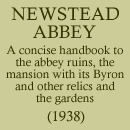To the right of the lawn will be seen a sunk garden planted with rose trees, lupins, spirseas and delphiniums. Arriving at the point maked "D" on the plan, the visitor may well spend a few moments in wandering about the numerous paths to the left, for they all give changing vistas of our attractive surroundings. These gardens of Newstead are for the most part old gardens and therein lies much of their charm—old lawns, old trees, an atmosphere of rest-fulness and repose which comes with age. In a new garden that has not yet "grown up" you can often see the whole at one view, but here at Newstead the long growth of trees and shrubs has created a fascinating maze in which the turning of every corner reveals a different picture.
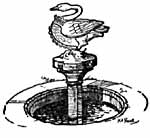
The Royal Swan.
Returning to the point marked "D" we have the gateway of the Kitchen Garden before us; let us pass through it, for even the kitchen gardens of Newstead have beauties of their own. Where else, indeed, can you see laburnums trained in arches as they are beside the central walk of this kitchen garden? The sight is surely unique, and when the trees are in bloom one walks between golden walls of luxuriant flowers—a truly gorgeous display of colour well worth, in itself, a special journey to Newstead. At stages where side-walks run at right angles into the main pathway are such decorative details as a stone sundial and circular lilypools, one of the latter having at its centre the carved stone figure of a royal swan, wearing a crown around its neck. Here also are numerous glass-houses in which vines and other fruit trees are carefully maintained or in which hothouse plants of various kinds display their exotic blooms.
From the Kitchen Garden we go forward to the Rose Garden—an older feature than the other collection of roses which we have previously seen in the Sunk Garden. To the north of the Rose Garden a long buttressed wall serves as the background for one of the finest collections of climbing and wall trees to be seen in the country; many of these are of special botanical interest. Beyond here again is the Tropical Garden where palms and other trees of the sunny south flourish in the open. The route next traverses a path flanked and arched over by ancient yew trees, many of them dating back to the days of the monks and certainly more than five centuries old. At the west end of the hollow beside which this path runs and which was the Stew Pond of the monastery is the Monks' Well, now known as the Wishing Well, concerning which it is declared that if you drink of its water and at the same time make a wish, the wish will come true; but it is an essential condition of the mystery that you record the wish in the secret of your own mind and tell it to no one until after it has been fulfilled. Most modern folk are inclined to be cynical about this kind of thing but whether it be merely the long arm of coincidence" or not, there are stories of remarkable results following the wishing of wishes at this well. One of the most notable and recent of them occurred during the Great War.
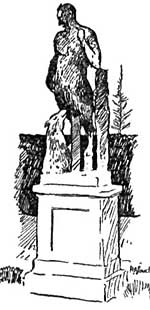
Satyr in Devil's Garden.
Now the route passes through a tunnel out beneath a raised terrace and through the farther opening of this we have our first glimpse of the Eagle Pond and adjoining gardens which extend from the east front of the Abbey. Before turning closer attention to the Pond, however, we should bear to the right into the broad open expanse of what has always been known as the Devil's Wood, so named from two old leaden figures of satyrs on pedestals which stand here, though the wood itself has disappeared. The surroundings here are entirely different from those which we have left on the other side of the tunnel. The various gardens we have previously seen are disposed after the manner of a natural landscape, generously interspersed with trees which screen off one part from another. Here, however, we are in a region of more formal gardening, with rectangular flowerbeds, terraces and stone balustrades.
The Eagle Pond which lies just below us is hardly a pond in the ordinary sense of the term; it is a large rectangular pool and takes its name not from it having been the resort of eagles but because the great eagle-shaped brass lectern of Newstead Abbey was recovered from its waters, into which it had been cast following the dissolution of the monastery. This splendid example of medieval metal work now has an honoured and appropriate place as the lectern of Southwell Minster, the grand old Norman Church which lies not many miles across country from Newstead. When the lectern was fished up, after having spent many years in the waters of this pond, a number of ancient parchment documents relating to the Abbey were found concealed within it, and it is a fine tribute to the work of the ancient craftsmen that their resting-place should have been so perfectly enclosed as to preserve them intact under such conditions. Some of these documents, still with their great wax seals attached, are now preserved within Newstead Abbey.
Close to the Eagle Pond, on the north side, is a very fine herbaceous border with a wonderful display of climbing shrubs on the sheltering wall. Passing from here round the north end of the Eagle Pond we make our way to one of the chief interests of the gardens on sentimental grounds, namely, "Boatswain's" Monument. This takes the form of a stone pedestal rising from circular steps and surmounted by an urn. On one face of the pedestal is inscribed Byron's famous poem in honour of his beloved companion, and this is worth quoting in full here:
Near this Spot
are deposited the remains of one
who possessed Beauty without Vanity,
Strength without Insolence,
Courage without Ferocity,
and all the Virtues of Man without his Vices.
This Praise, which would be unmeaning Flattery
if inscribed over human Ashes
is but a just tribute to the Memory of
BOATSWAIN, a DOG
who was born in Newfoundland, May 1803
and died at Newstead, Nov. 18th, 1808.
When some proud Son of Man returns to Earth,
Unknown to Glory, but upheld by Birth,
The sculptor's art exhausts the pomp of woe
And storied urns record who rests below.
When all is done, upon the Tomb is seen
Not what he was, but what he should have been.
But the poor Dog, in life the firmest friend,
The first to welcome, foremost to defend,
Whose honest heart is still his Master's own,
Who labours, fights, lives, breathes for him alone,
Unhonour'd falls, unnotic'd all his worth,
Deny'd in heaven the Soul he held on earth.
While man, vain insect! hopes to be forgiven
And claims himself a sole exclusive heaven.
Oh, man ! thou feeble tenant of an hour,
Debas'd by slavery, or corrupt by power,
Who knows thee well, must quit
thee with disgust,
Degraded mass of animated dust!
Thy love is lust, thy friendship all a cheat,
Thy tongue hypocrisy, thy heart deceit,
By nature vile, ennobled but by name,
Each kindred brute might bid thee blush for shame.
Ye ! who behold perchance this simple urn,
Pass on, it honours none you wish to mourn.
To mark a friend's remains these stones arise,
I never knew but one—and here he lies.
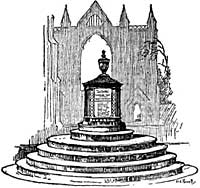 Boatswain's Grave.
Boatswain's Grave. A very fine sentiment on Lord Byron's part—a trifle exaggerated here and there, it is true, but containing only one serious mistake and that is his supposition that none of us who come to look upon "Boatswain's" tomb would "wish to mourn" the passing of a noble dog. For, on the contrary, a good many of us will decline to pass on, as he bids us do, without recollecting with gratitude the fine friendship of many a dog symbolized by his own devoted companion.
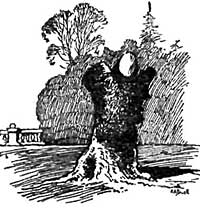 Byron's Oak.
Byron's Oak. In order to complete our tour of the gardens, we must now return to the tunnel, and, passing through it again, take the path to the right. This shortly brings us to the north side of the broad expanse of greensward which we passed on its south side as we walked along the path by the Garden Lake. In solitary dignity upon this great lawn stands all that is left of Byron's Oak—the trunk of a once noble tree, now covered with ivy. The tree was planted by Lord Byron himself on his first coming to Newstead in 1798. It looks so venerable now that one might easily suppose it to be older than 134 years. The writer of an old guide to Newstead, published at about the middle of the 19th century, remarks of this tree that, "during the little more than half a century of its existence, it has grown with a vigour and beauty quite astonishing, and it bids fair to become a durable memento of the bard and a shrine to which his admirers for many future ages may fitly resort." The prophecy as to its durability has been only incompletely fulfilled, for the tree is dead and survives only as a huge stump. There is something pathetic in this, for the writer we have just quoted tells us that "his lordship displayed a remarkable regard for this tree, actuated, it is said, by the singular impression that as the tree flourished, so should he— "as it fares, so will my fortunes fare." He must have considered it an ill omen, therefore, when, on returning to Newstead in 1807, he "found his favourite sapling sickly and dwindling and almost choked up with weeds." It was on this occasion that he wrote the lines:
Young oak, when I planted thee deep in the ground
I hoped that thy
days would be longer than mine,
That thy dark waving branches would
flourish around
And ivy thy trunk with its mantle entwine.
Such, such was my hope when in infancy's
years
On the land of my fathers
I rear'd thee with pride,
They are past, and I water thy stem with
my tears,
Thy decay, not the weeds that surround thee can hide.*
When Colonel Wildman entered into possession of Newstead later in the century, he considered the tree an interruption of the lawn's fine sweep, and although admiring it as a fine young oak, gave orders for its execution. His gardener, however, pleaded for the life of the tree on account of Lord Byron's attachment to it, and it was not only spared but "nurtured with the most anxious solicitude." Now it is dead; but Byron has outlived his tree by the immortality of his writings.
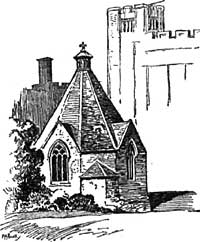
The Prior's Kitchen.
From this part of the grounds we may take a close view of one of the most interesting fragments of the monastic buildings— one which it is not possible for visitors to inspect on their tour of the interior of the Abbey. This is the Prior's Kitchen, with its octagonal pyramid roof, which will impress the travelled visitor at once with its strong similarity to the famous Abbot's Kitchen of Glastonbury Abbey in Somerset. In essential form the two buildings are identical.
Just beyond here we find ourselves back at the entrance to the gardens, and our tour is complete, save that most visitors like to walk across from here to the waterfall which descends from the Upper Lake and give themselves the unusual experience of actually standing beneath the fall— hiding, as it were, behind the curtain of falling water.
Thus the task of describing Newstead as it stands to-day is finished; to do it full justice would require many more pages than the writer has at his disposal, and the last verse of Lord Byron's elegy on Newstead Abbey may provide a fitting finish:
Haply thy sun, emerging, yet may shine,
Thee to irradiate with meridian
ray;
Hours splendid as the past may still be thine,
And bless thy future
as thy former day.
